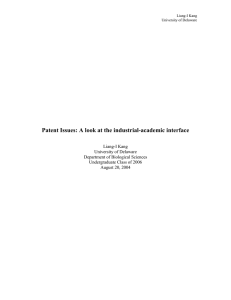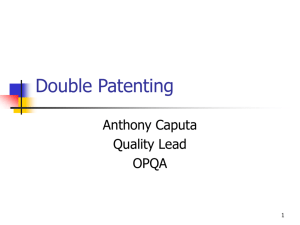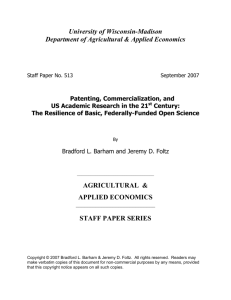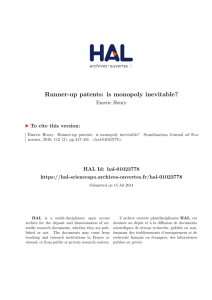The Business of Manipulating Life, US Decision on Genetic
advertisement
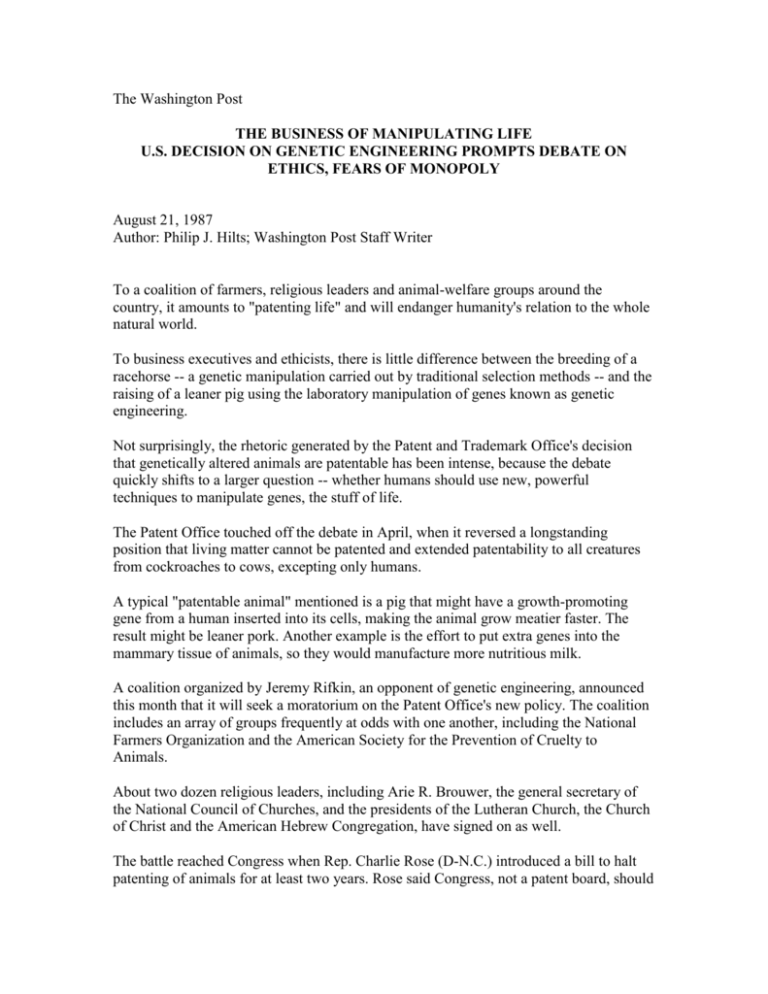
The Washington Post
THE BUSINESS OF MANIPULATING LIFE
U.S. DECISION ON GENETIC ENGINEERING PROMPTS DEBATE ON
ETHICS, FEARS OF MONOPOLY
August 21, 1987
Author: Philip J. Hilts; Washington Post Staff Writer
To a coalition of farmers, religious leaders and animal-welfare groups around the
country, it amounts to "patenting life" and will endanger humanity's relation to the whole
natural world.
To business executives and ethicists, there is little difference between the breeding of a
racehorse -- a genetic manipulation carried out by traditional selection methods -- and the
raising of a leaner pig using the laboratory manipulation of genes known as genetic
engineering.
Not surprisingly, the rhetoric generated by the Patent and Trademark Office's decision
that genetically altered animals are patentable has been intense, because the debate
quickly shifts to a larger question -- whether humans should use new, powerful
techniques to manipulate genes, the stuff of life.
The Patent Office touched off the debate in April, when it reversed a longstanding
position that living matter cannot be patented and extended patentability to all creatures
from cockroaches to cows, excepting only humans.
A typical "patentable animal" mentioned is a pig that might have a growth-promoting
gene from a human inserted into its cells, making the animal grow meatier faster. The
result might be leaner pork. Another example is the effort to put extra genes into the
mammary tissue of animals, so they would manufacture more nutritious milk.
A coalition organized by Jeremy Rifkin, an opponent of genetic engineering, announced
this month that it will seek a moratorium on the Patent Office's new policy. The coalition
includes an array of groups frequently at odds with one another, including the National
Farmers Organization and the American Society for the Prevention of Cruelty to
Animals.
About two dozen religious leaders, including Arie R. Brouwer, the general secretary of
the National Council of Churches, and the presidents of the Lutheran Church, the Church
of Christ and the American Hebrew Congregation, have signed on as well.
The battle reached Congress when Rep. Charlie Rose (D-N.C.) introduced a bill to halt
patenting of animals for at least two years. Rose said Congress, not a patent board, should
decide a matter as sensitive as patenting animals. Sen. Mark O. Hatfield (R-Ore.) is
expected to introduce a similar bill in the Senate after Labor Day.
Industry analysts and officers of companies involved in agricultural biotechnology, who
mostly favor the patent policy, say it is more symbolic than practical now because there is
so little work going on in the area of altering animal genes commercially that the policy
will probably have very little effect for some time.
Richard Godown, head of the Industrial Biotechnology Association, praises the policy as
a step that will encourage companies to invest in research that could produce major gains
in agricultural productivity, and give a boost to one of the few major high-technology
industries in which the United States still clearly leads the world.
He said that the breeding of animals for new, desirable traits -- whether genes are
changed by traditional breeding or by chemical manipulation -- is an ancient practice and
that patenting the new breeds will only give inventors a commercial advantage, not
change mankind's relation to nature any more than the breeding of the "beefalo" or the
"geep" (a cross between a goat and a sheep) has done.
Ever since humans acquired the power to read and alter the essential physical elements of
life -- the genes of all creatures -- people have worried and argued about what should be
done with this knowledge.
Along with the realization that life is chemical machinery that can be manipulated came
the question of whether inventions that alter this machinery ought to be as patentable as
other mechanical inventions.
Patenting animals, said Rifkin, who heads the Foundation on Economic Trends, "reduces
the entire animal kingdom to the lowly status of commercial products . . . . Do we want
our children to think of animals as patented products made by chemical companies and
owned by the private sector?"
"We would not allow someone to put an animal gene in to make our children grow twice
as fast. Why would we allow that for animals? Are they here purely as utility?"
Farm groups raised a different concern. They said if animals are patented, the improved
breeds that result from the patenting might be controlled by a few large companies.
The parallels suggested are with plants, which are patentable. Half a dozen companies
with the best seed varieties control the seed sales for a large segment of American and
world agriculture.
Already, in poultry breeding, less than two dozen companies control the bulk of U.S.
production.
Cy Carpenter, president of the National Farmers Union, raised the question in
congressional testimony recently: "Will animal patenting result in greater concentration
in those who produce breeding stock, as it has in in the seed industry . . . ? What impact
will this have on the consumer if animal producers are forced to pay royalties to the
owners of patents?"
Patent Commissioner Donald J. Quigg said at least 15 patents are pending that might
involve the question of patenting animals, but said none is likely to be decided for
months.
He pointed out that patents were created to encourage inventors by giving them
commercial protection, allowing them to sell their inventions for some years without
facing competition. The first living thing for which a patent was granted was a yeast "free
from germs of disease" in 1873. It was made by Louis Pasteur.
But as a matter of policy, living organisms were not considered patentable, except for
plants that Congress said could be patented in laws passed in 1930 and 1970.
Then, in a major decision, the Supreme Court took on the issue of patenting life for the
first time, in a 1980 case called Diamond v. Chakrabarty. Ananada Chakrabarty was then
a corporate researcher who had used genetic engineering to make an oil-eating microbe
unlike any found in nature.
The high court decided that patents should be granted for inventions, whether they are
living or not. The new policy simply extended patent protection from bacteria to other
living things.
Giving such protection to the breeding of animals with new traits follows a simple logic,
according to LeRoy Walters, director of the Kennedy Institute for Bioethics at
Georgetown University.
Walters said that if animals can be owned and sold, it follows that some special rules can
be established giving some commercial advantage to one seller. The breeding of prize
animals such as bulls and Kentucky Derby winners is similar in some ways, he said.
"As long as we keep clear the obligation to treat animals humanely, this doesn't really
raise any new ethical questions . . . . In the long run it could be in the interest of animals
to have recombinant DNA technology employed. It could mean less disease and suffering
for them," Walters said.
Much of the rhetoric, meanwhile, is about the power mankind has acquired over genes,
not patents.
"We ought to thank the Patent Office for giving us an opportunity to make this {genetic
engineering in animals} a public issue," said Michael Fox, scientific director of the
Humane Society of the United States
Copyright 1987 The Washington Post
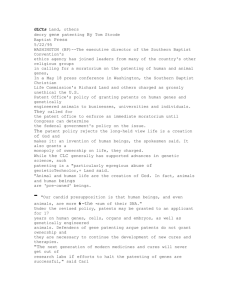
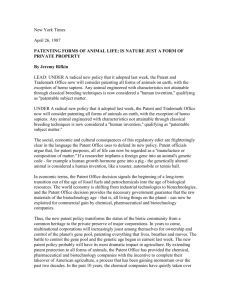
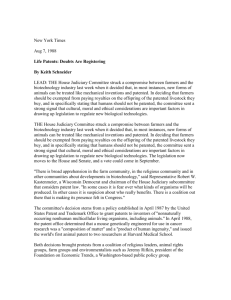
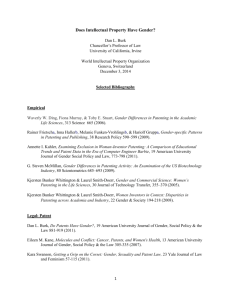


![Introduction [max 1 pg]](http://s3.studylib.net/store/data/007168054_1-d63441680c3a2b0b41ae7f89ed2aefb8-300x300.png)

